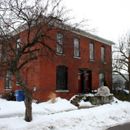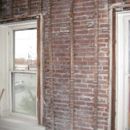Masonry Interior Retrofit: Foam-less advice

Opinions please:
We’ve got a project where we are proposing to insulate an existing 19th century brick building in northern NY state to the interior with cellulose with the goal of a minimal spray foam retrofit.
Reasons for avoiding foam include permitting renovation in the future by not glueing the building together, toxicity & GHG blowing agents in US spray foam. Some foam will still likely be used for air sealing at tricky areas, but want to avoid it as much as possible.
Building is a triple wythe brick building with no visible signs of water intrusion on the interior face of brick, staining or the like, exterior has been repointed for this job. It’s in really good shape overall. If we insulate to the interior, the brick will now stay cold all winter, but this building has not been occupied full time for the past decade, so it’s survived cold walls already.
Interior face of brick has vertical wood furring strips attached to the brick that used to support the plaster and lathe.
Proposed plan is as follows:
Staple Typar or Asphalt Felt to the vertical furring strips, tie into window openings with construction tape.
Build 2×4 stud wall off face of brick for a total cavity of 10″ (R-3.8 x 10″ = R-35+)
Wire rough-in.
1/2″ CDX Plywood interior sheathing as airbarrier, taped and sealed to existing floor boards and ceiling, pieced into joist bays for continuity as best possible.
Drywall on Plywood.
Theory is to create interior air barrier, allow drying to outside. Typar or Asphalt felt will prevent any moisture intrusion from wetting the cellulose, but still allow drying outward.
Options instead of the Typar to serve as a WRB / air barrier on brick include StoGuard EmeraldCoat (http://www.stocorp.com/index.php/component/option,com_catalog2/Itemid,196/catID,38/catLevel,3/lang,en/subCatID,128/subCatIDnext,131/) or Thoroseal (http://www.thoroproducts.com/products_waterproofing.htm) parged onto interior face of brick for WRB and air sealing.
Any thoughts about this plan from everyone? Any experience with these techniques out there?
GBA Detail Library
A collection of one thousand construction details organized by climate and house part











Replies
other than losing a significant chunk of interior space along the perimeter?
alternative insulations - mineral wool or foamglas? also, any thoughts to going the euro PH route and insulating the exterior or is the building already pushed up to setbacks?
There's plenty of space inside, it's a 32' x 32' building. It's really not a big deal to lose 10" on all sides, that's why we're not trying to optimize with expensive higher R materials.
Mineral wool might be possible, but we've been much more comfortable getting consistent insulation coverage with blown-in products. Batt insulations are just too difficult to get consistent coverage in my experience (see Carl Seville's recent posting). Mineral wool is tougher than cellulose if there might be water intrusion, however.
Not that it will change your mind, but you will lose around 100 square feet. A small bedroom. 10 percent of your floor space.
cellulose up to masonry wouldn't be my first choice..........is EPS out of the question?
I would be out of my depth regarding drying direction but wouldn't that brick tend to stay damp in that locale ?
Jesse,
I'm at the building science symposium in Westford right now. I was standing in line waiting for lunch with Chris Benedict, who (as you know) has insulated several NYC brick buildings with cellulose on the interior walls. She said that they have opened up several walls over the years, and the cellulose always looks pristine.
However, she recommended that you do a WUFI analysis of the proposed wall assembly -- with the usual caveat that the analysis has to be done by someone who really understands WUFI deeply (to eliminate the garbage in, garbage out problem). The most dangerous climates are those with regular spells of heavy rain followed by freezing conditions.
Thanks Martin. Any tips you can get out of Chris for techniques up against the brick layer would be appreciated.
I've used WUFI just enough to know how easy it is to get bad information out, I would agree it's far too easy for an amateur like me to create bad analysis with it.